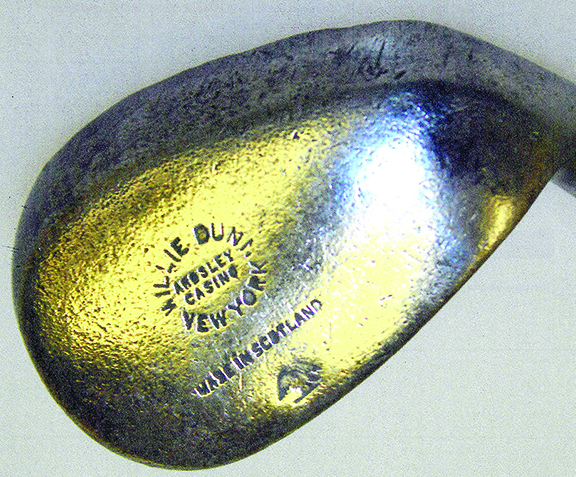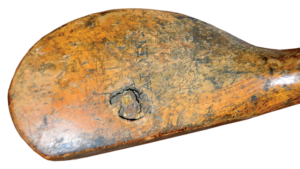
 By Wayne McGinnis
By Wayne McGinnis
Wayne McGinnis, Ph.D., Arkadelphia, Ark., retired from teaching English in college in 2016, after 43 years. He has been collecting golf items since the 1980s and is especially interested in early American golf clubs and associated memorabilia.
It is uncontested that the first manufacturer of golf clubs in the U.S. was A. G. Spalding & Bros. of Chicopee, Mass. And theywere among the first to sell golf clubs, although ones made in Scotland, as attested by an ad on the back cover of the first golf “book” published in America, Spalding’s Athletic Library, Vol. 1, No. 8, “Golf,” dated May 1893, edited by J. Stuart Balfour. On the booklet’s back cover the company’s “St. Andrew’s [sic] Trade Mark” clubs are enumerated. Listed are six wooden clubs and six men’s irons and two ladies’. They are advertised as “Warranted the Best Scotch Made.” We also know from the July-September 1893, Journal of American Folklore that Spalding exhibited golf clubs at the Chicago World’s Columbian Exposition of 1893, which ran from May through October.
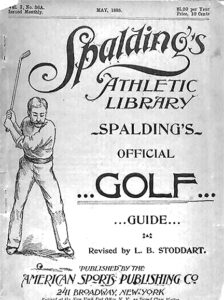
As for the actual manufacture of golf clubs by Spalding, we can nominate 1894 as the year if, for one thing, we takeas our guide an ad by Spald- ing in Golf [NY], September 1898, which states that the company “had commencedmaking clubs four years ago.” Jim Cooper, “the Spalding Man,” believed that the first clubs actually made by Spalding were produced at its Chicago plant in 1894 and marked “S.M.Co.” or “Spalding/ M.C.” However, while the Spalding/M.C. mark is rare, the S.M.Co. mark can be found with slight regularity, indicating that it may have coexisted with other Spalding models. Actual production of Spalding clubs probably originated at its Chicopee, Mass., factory sometime in 1894, after A. G. Spalding himself bought – in 1893 – the plant of the Lamb Knitting Machine Manufacturing Company in Chicopee.
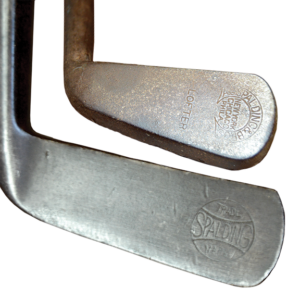
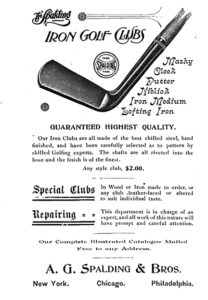
Unfortunately, no issue of Spalding’s Athletic Library for golf seems to exist for 1894. The second golf edition of the Library, Vol. 3, No. 36A, Spalding’s Official Golf Guide, revised by L.B.Stoddard, dates May 1895. Stoddard himself writes in this Guide, “A. G. Spalding & Bros. have been mak- ing clubs now for over a year.” This would establish the date of first club making as sometime in early 1894. The same would go for Wright & Ditson clubs, this company having been incorporatedinto Spalding around 1892. The first cleek marks for these clubs would be “A. G. Spalding & Bros” in a horseshoe shape; the single baseball mark; and just the word SPALDING, roughly in that order, I believe, with WRIGHT & DITSON in a semicircle being its earliest mark.
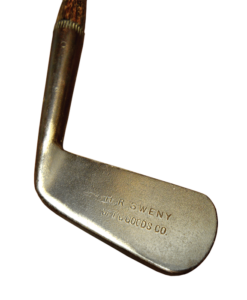
Skipping to the next date, 1896, three manufacturers occur: Henry [also, “Harry”] Roy Sweny of Albany,N.Y., Warren R. Briggs of Bridgeport, Conn., and the Overman Wheel Co. of Chicopee Falls, Mass. Sweny patented a center-shafted driver (the sixth U.S. patent for a golf club), sometimes called a “horse’s-hoof club,” on Aug. 13, 1896. He wrote about it earlier in The Golfer (Boston) on June 24, and filed the patent on March 20, 1896. The club was sold by Sweny Sporting Goods Co., 72 State St., Albany, among other clubs Sweny retailed. Apparently Sweny produced clubs under the name “U. S. Golf Club Mfg. Co.” at some point, as the April 1899, issue of Golf [N.Y.] reports that he had sold out this company to Golf Goods Mfg. Co. of Binghamton, N.Y., that year. Sweny was indeed a well known golfer, playing in the U.S. Open in 1897, 1898, and 1899, and had published one early instruction book, Keep Your Eye on the Ball and Your Right Knee Stiff, in 1898.
Warren Briggs patented a fork-spliced driver (the third and fourth U.S. golf club patents) on March 10, 1896 (filed 12/26/95 and 1/7/96). In January 1900, Golf [N.Y.] reported that Briggs “was one of the first in this country to start a factory for making golf clubs. His venture was known as the Outing Goods Manfg. Co.” In his The Clubmaker’s Art, 2nd ed., Jeff Ellis notes that only three (left-handed) Briggs fork-sliced clubs still exist, marked “Brooklawn” in red ink stamped onto the wood (161). Brooklawn was Briggs’ home club in Bridgeport. The Briggs patent fork-spliced club, driver and brassey, was later sold by B.G.I., as listed in its retail catalogue, Seasons 1900-1901. The golf press took notice: “The latest novelty in golf clubs is the fork spliced driver made by Bridgeport Gun Implement Company” (Golf [N.Y.], Jan., 1900, 13).
The third maker dating definitely to 1896 (and prob- ably to 1895) is the Overman Wheel Company of Chicopee Falls, Mass., makers of the first “safety bike,” the famous “Victor.” Evidence of the earlier 1895 golf date is the pub- lication in that year of tennis star James Dwight’s Golf: A Handbook for Beginners (Boston: Overman Wheel Com- pany, “Makers of Victor Bicycles and Athletic Goods”).
This is the same year as James P. Lee’s Golf in America, considered the first true U.S. golf book. However, no advertising for OWCo’s golf goods exists for 1895, as far as I know. A bicycle booklet, Victor Sunlights, c. 1895, lists its Victor Sporting Goods Division as manufacturing “Base Balls, Base Ball Bats, Tennis Balls, Tennis Racquets, Foot Balls, Roller Balls,” but not golf equipment. The first printed evidence I’ve found for their golf output comes from a University of Michigan student publication, The Islander, November 1896, where an OWCo. advertisement mentions a “complete line” of “golf goods.”
True Overman Wheel golf clubs are marked “O.W.CO.,” with usually “Victor” or “The Victor” added. In 1898 the Victor Athletic Goods division of Overman Wheel was taken over by the new “Victor Sporting Goods Co.” at the same Overman plant, until 1900, when OWCo. officially closed. Victor Sporting Goods Co. then moved to Spring- field, Mass., still producing “The Victor” clubs, as adver- tised, for example, in the Sears, Roebuck Fall catalog of 1900 (along with the cheaper “The Country Club” woods in the same catalog). Albert Overman went on to organize the Overman Automobile Co, from 1901 to 1904, producing The Victor steam carriage.
Going on to 1897, we have evidence that MacGregor made its first clubs then. Robert D. Rickey, son of Mac- Gregor head Clarence Rickey, states in his manuscript “The History of MacGregor 1829 to 1979” (www.scribd.com), “In 1897, the Crawford, McGregor & Canby Co. of Dayton, Ohio, made its first golf club. In order to be able to manufacture irons as well as woods, a forge shop was added to McGregor’s existing facilities. However, the Crawford, McGregor & Canby Co.’s principal product continued to be shoe lasts for several more years” (3).
Another source, the Miami Valley Golf Association (www.miamivalleygolf.com), says that pro Robert White of the Cincinnati Golf Club suggested the making of club heads to golf enthusiast Edward Canby, and so in March 1897 McGregor diversified into golf clubs. In March 1898 the famous Willie Dunn was hired to supervise the making of clubs. Thus, the first known irons of MacGregor have the Willie Dunn “bow tie” cleek mark. Evidence is that J. H. WIlliams Drop Forging of Brooklyn even forged some of these early iron heads (by 1900, B.G.I. claimed all of J. H. Williams’ production). Around 1900, “J. MacGregor” appeared on club heads.
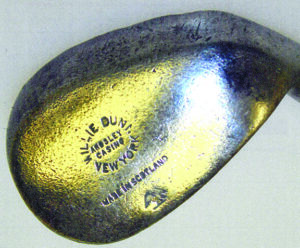
Mention should be made of Willie Dunn Jr. as an independent club maker. Everyone has seen woods and irons stamped “Willie Dunn/New York,” (example shown above) with sometimes a “McGregor” stamped shaft. Dunn assembled clubs in New York City on his own and at one time ran a golf school. In the July 1898, issue of Golf [N.Y,], Dunn has an “Opening Announcement”: “Willie Dunn, Golf Club and Ball Manufacturer, begs to announce to the Golfing public that he has opened his new uptown store at 9 Seymour Bldg., E. 42nd St. . . All my clubs are made by experienced men who can play Golf.” In the January 1900 issue of Golf an ad states, “The only genuine Willie Dunn Clubs are stamped on head and shaft “Willie Dunn, New York” and made at his New York factory. The Crawford, McGregor & Canby clubs are no longer under his supervision” (64).
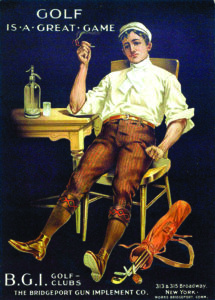
The year 1897 also brings us to Bridgeport Gun Implement Company. According to Pete Georgiady in his North American Club Makers (1998), “B.G.I. offered its first golf clubs in late 1896 or 1897. It had an aggressive marketing and advertising plan rivaling Spalding and Wright & Ditson, its chief competitors. Business showed a marked improvement when the firm hired Willie Dunn in 1897 to design clubs and supervise manufacturing. Dunn was only in charge for a brief period but he accomplished a lot. After his departure in 1898 [to MacGregor] his efforts were sustained by his nephew John Duncan Dunn” (176). Early B.G.I. irons – those with arrow and feathers on the sides – were probably made by Spalding. By 1898, J. H. Williams Drop Forging Company of the Redhook district of Brooklyn was supplying forged heads, with the Williams’ numbering corresponding to the system B.G.I. used. Using Don Paris’ book on the B.G.I. Company, I found that J. H. Williams ads seem to date from early 1898, nor do ads for B.G.I. show up earlier than that. B.G.I. woods were entirely their own product from the beginning. It seems certain that both B.G.I. and MacGregor began in 1897, the year Spalding was introducing its “The Spalding” line.
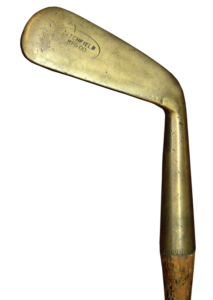
In December 1897, the Litchfield [Connecticut] Mfg. Co. placed an ad in The Golfer [Boston] recommending its “gold bronze” golf clubs for Christmas giving. I have one such club (shown above) made of a bronze alloy and having a large, prominent hosel, its cleek mark an oval with “Litchfield Mfg. Co.” This small company probably wasn’t in business much beyond the date of its ad, judging by the scarcity of its clubs. Independent producers of novel clubs are scattered somewhat later in golf’s early history – Dr. J. H. Dwight’s “Directional Clubs” of 1911 come to mind.

This brings us to the end of the 19th century as far as golf club making in America. Another important early manufacturer did exist between January 1901 and August 1902, the Hunt Factory in Westboro, Mass., originally a bicycle maker. The company’s clubs were of a unique non-rustable yellowish metal, with the shafts marked “Hunt Mfg. Co. / A. & C. P. Co., Westboro, Mass.,” (example shown above) the latter for the owner of the plant, the Automobile & Cycle Parts Company of Cleveland, Ohio. The iron clubs, as well as their “bead shaft” scare headed woods, are very collectible.
In conclusion, it does seem telling that the two companies that survived the longest, Spalding and MacGregor, were the ones that had the fullest capacity to make golf clubs in their entirety. Why equally competent makers fell away is a matter of conjecture.

